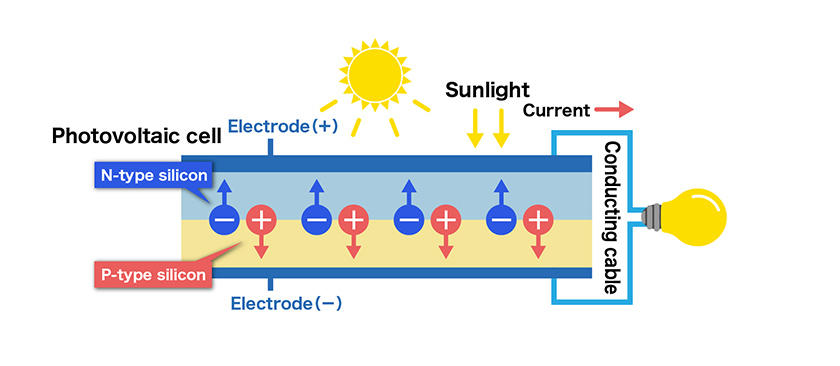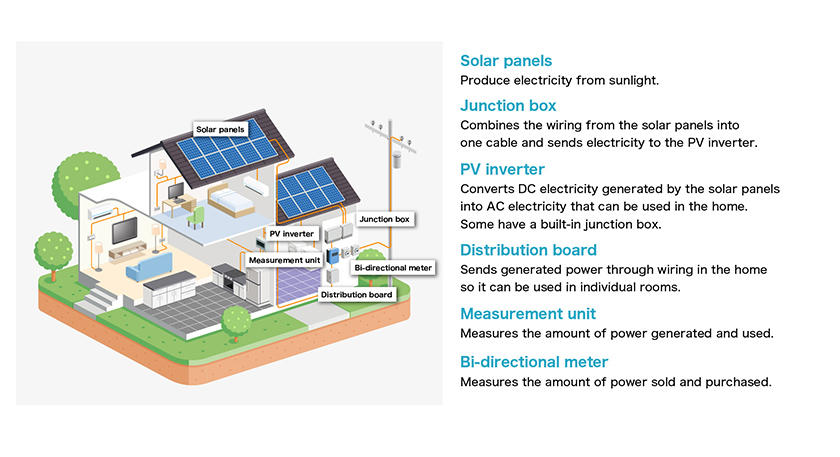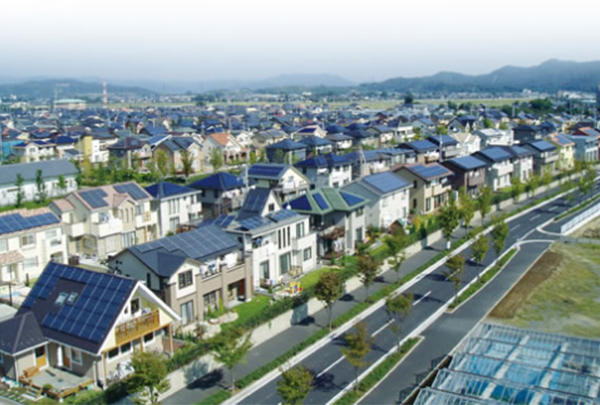
Did you know Japan is one of the countries that installation of solar power is widespread? Looking at the amount of power generated by country, Japan generates around 63 million kW*1 annually, making it the third largest producer of solar power after China and the US. In this article, we will explain how solar power works in a way that is easy to understand.
*1: For more detail please see the NPO Institute for Sustainable Energy Policies' "Domestic FY 2019 Share and Implementation of Natural Energy" (in Japanese only)
The first thing that comes to mind when you hear "solar power" is probably solar panels installed on the roofs of buildings or large areas on the ground. Solar panels contain PV cells (photovoltaic cells). PV cells convert light energy into electrical energy, but unlike dry cells, they cannot store electricity. A solar panel is composed of many PV cells placed side by side, covered with a protective material such as plastic or glass so it can be used outdoors.
When sunlight hits the PV cells in the solar panels, a phenomenon called a "photoelectric effect" occurs. Photoelectric effect refers to the emission of electrons and electricity by a material when it is hit by light. This phenomenon can be utilized to change light into electricity.
Today most PV cells use semiconductors made from materials such as silicon that are susceptible to this photoelectric effect. PV cells that use silicon combine two types of silicon semiconductors together: p-type silicon semiconductors, which contain more positive charge carriers, and n-type silicon semiconductors, which contain mostly negative charge carriers. When sunlight hits the boundary between the semiconductors, the semiconductors become charged positively and negatively respectively, and generate DC electricity. PV cells generally have an energy conversion efficiency (the percentage of light that can be converted into electricity) of about 14% to 20%. And since the amount of electricity generated depends on the intensity of the light, solar panels are installed at the most efficient angle for generating electricity in locations that get plenty of sunlight throughout the year.

The electricity generated by solar panels is sent to a distribution board in the home, but since it is DC electricity (DC)*2 it cannot be used directly in homes. The reason is that the electricity normally used in our homes that is transmitted by power companies is AC electricity (AC)*3 and home appliances are made to use that type of electricity. So DC needs to be converted to AC, and that is where a device called a "PV inverter" comes in. PV inverters send the power converted to AC to the distribution board that supplies each floor and room with electricity. But that is not all they do. They also play the important role of enabling homes to continue using electricity in a power outage caused by a disaster and of preventing trouble if there are any irregularities in the generated electricity. OMRON has been offering PV inverters for over 25 years, since 1994, before solar power became widespread in Japan. Today many residential solar power systems use OMRON PV inverters.

*2: DC (direct current) electricity is a type of electrical current, in which the current and voltage do not change, and one pole is always negative, and the other pole is always positive.
*3: AC (alternating current) electricity is a type of electrical current, in which the current and voltage change, and alternates between negative and positive.
Solar power--generating electricity from sunlight--is very convenient. But there were many challenges to overcome for it to become widespread in Japan. One was the restrictions in installing solar power systems.
Solar power systems are equipped with an anti-islanding control function that cuts off the connection between transmission lines and the solar power system when a problem such as power outage occurs. "Islanding" is when a solar power system continues to send power to transmission lines that do not have electricity running through them. This can result in electrocuting the workers who are trying to bring the power back on or starting a fire. Anti-islanding control function prevents such electrical accidents, but since the means of detecting islanding differed by manufacturer, they could interfere with each other and cause islanding. For this reason, restrictions on the quantity of solar power system installations were placed on the Japanese power industry, to the point that solar power systems could only be installed in about 10% of the homes in a given community.
In 2002, OMRON started developing technology to solve this issue. We were contracted by the New Energy and Industrial Technology Development Organization (NEDO) to carry out a "Demonstrative Research on Clustered PV Systems."*4 The study was carried out in the Pal Town Josai-no-Mori located in Ota City, Gunma Prefecture. With the cooperation of residents, solar power systems were installed on a total of 553 homes, producing a total of 2,129 kW of electricity and making it one of the largest "solar towns" in the world.

Based on the knowledge gained in this research, OMRON became the first in the industry to develop anti-islanding control technology for use when several systems are installed close together. Called AICOT®,*5 in 2011 we launched a PV inverter equipped with the new technology. Because AICOT® can stop islanding rapidly by detecting it in 0.2 seconds from variations in frequency, there is little risk of interference and no restrictions on installation. As a result, restrictions on installation were no longer needed, and solar power systems could now be installed throughout an entire community. And to promote the further spread of solar power, OMRON released the patent of the technology that took eight years to develop to the public. Today a variety of manufacturers use the technology in their PV inverters.
*4: Kandenko Co., Ltd. was contracted by NEDO, and OMRON was then subcontracted to develop and provide the islanding technology.
*5: AICOT® (Anti-Islanding Control Technology) is a technology to prevent the risk of islanding operation of solar power generation system when power failure occurs due to the accident. OMRON is the first in the industry to develop this technology that can be used while multiple units are connected. For details on AICOT® (Anti-Islanding Control Technology) please visit: (in Japanese only)
Recently, Sustainable Development Goals (SDGs) have been gaining more and more attention in a variety of media. Comprising 17 international goals that aim to create a better, sustainable world by 2030, SDGs have become something of slogan for the world.*6
The seventh SDG is "Affordable and clean energy: Ensure access to affordable, reliable, sustainable and modern energy for all." It aims to spread the use of energy that does not emit substances such as carbon dioxide (CO2), which is a cause of global warming, and sulfur oxides (SOx) and nitrogen oxides (NOx), which cause air pollution. Common examples of this kind of energy are solar power, geothermal power, and wind power. Since these forms of energy do not pollute the environment, they are referred to as "clean energy," and the governments of world, including Japan, are working to make their use more widespread.

Through innovations created with OMRON's proprietary technology, AICOT®, we have contributed to the spread of solar power. We will continue to contribute to spreading clean energy with advanced technology. And we will strive to create a sustainable society where everyone living on Earth can use clean energy.
*6: For details please visit the Ministry of Foreign Affairs' "What is the SDGs?"